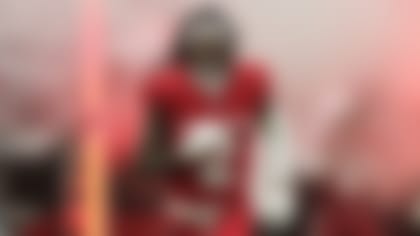After watching prolific passing attacks rule the roost in the NFC West for decades, observers should ready themselves for a dramatic change this season.
Fueled by a desire to return to old-school football, the division is undergoing a transformation. Once home to legendary aerial attacks like Joe Montana to Jerry Rice and "The Greatest Show on Turf," the running game is now paramount to capturing the NFC West crown.
With only one proven quarterback (Matt Hasselbeck), it's not surprising the division features multiple teams that rely on their ground attacks.
Let's examine how each NFC West squad plans to utilize their respective running game to spearhead the offense.
Arizona Cardinals
The departures of Kurt Warner and Anquan Boldin will force the back-to-back NFC West champs to alter their offensive strategy in 2010.
Cardinals built to adapt
Despite several changes this offseason, Arizona is confident that young players such as Matt Leinart are ready to play a larger role, writes Vic Carucci. **More ...**
After torching foes with a high-octane attack that revolved around a quick-rhythm passing game from multiple spread formations, the Cardinals are morphing into a smash-mouth offense that will hammer opponents between the tackles.
In anticipation of the philosophical change, Arizona completely retooled its offensive line, resulting in four new starters.
While Reggie Wells and Levi Brown will simply flip sides in the change (Wells will move from left to right guard, while Brown shifts from right to left tackle), the promotion of Brandon Keith at right tackle and addition of veteran guard Alan Faneca adds some pop to the team's rushing attack.
Faneca, a nine-time Pro Bowler, is adept at drive blocking and his ability to create a push at the point of attack will allow coach Ken Whisenhunt to direct more of his runs up the middle. With Beanie Wells emerging as the feature back down the stretch last season, the Cardinals are seemingly ready to become a blue-collar unit, going back to Whisenhunt's roots with the Pittsburgh Steelers.
Wells rushed for 793 yards with seven touchdowns as a rookie. He gives the team a physical, downhill runner who also has explosive speed and quickness. Though he failed to start in his first season, he's the kind of power runner capable of toting the rock 20-25 times a game.
Given the insertion of Matt Leinart as the starter, a steady workhorse in the backfield will help alleviate some of the pressure on the inexperienced quarterback. It will also help the Cardinals stay in games as they adjust to a drastically different offensive approach.
San Francisco 49ers
Mike Singletary has often stated his preference for smash-mouth football, and his offense is shaping up to be capable of bludgeoning opponents.
Led by two-time Pro Bowler Frank Gore, the 49ers are primed to run between the tackles. Gore, one of the most feared backs in the league, has gained over 1,000 yards on the ground four consecutive years. Although he's seen his carry total decrease in each of the past three seasons, Gore's yards per carry average has rebounded from a career-low 4.2 in 2007 to 4.3 and 4.9 the past two years. He's also coming off a season in which he produced five 100-yard rushing games, including three in the team's last four contests.
Gore's production is even more remarkable considering he ran behind a makeshift offensive line unable to create a consistent push. The lack of holes in the running game was such an issue that the team used their two first-round picks to address the problem.
Anthony Davis, the 11th overall selection in the 2010 draft, gives San Francisco a hulking presence at right tackle, while fellow first rounder Mike Iupati will boost the interior of the line at guard. Both will have to earn starting spots through their play in the preseason, but it's safe to assume each will have every opportunity to crack the lineup. Their size and strength will eventually upgrade the unit.
With an offensive line that looks vastly improved on paper, coordinator Jimmy Raye will feel more comfortable sticking with the running game that he seemingly shelved at times last season. Part of that was due to the improved production of quarterback Alex Smith when the team used more spread-like formations. He thrived throwing the ball in quick-rhythm situations, and the offense fared better with Smith operating an attack similar to the system he directed in college.
However, this team is built to run the ball extensively and that commitment will ultimately determine the 49ers' level of success. With Gore and rookie Anthony Dixon running behind an upgraded frontline, opponents should fear San Francisco's decision to opt for three yards and a cloud of dust.
Seattle Seahawks
Coach Pete Carroll's arrival has led to a change in the Seahawks' offensive philosophy. Seattle is shifting from the pass-first tactics favored by Mike Holmgren to a more balanced strategy that will emphasize a physical running game.
Carroll's hiring zone-running guru Alex Gibbs is indicative of his desire to pound the ball between the tackles. Gibbs, who has orchestrated several top-ranked rushing attacks during his illustrious career, is installing his vaunted zone-based scheme in Seattle. The simple design will allow the Seahawks' runners to be decisive with reads.
In Gibbs' system, offensive linemen block defenders that step into their assigned areas rather than take on the man aligned over top of them. The scheme often assigns multiple players to work together through areas to create a series of initial double teams at the point of attack. The beauty of utilizing the method is that it allows blockers to be aggressive off the ball due to the presence of help from a teammate. When used in conjunction with the one-cut rule (backs are allowed to only make one-cut before attacking the line of scrimmage in an effort to limit negative plays), the scheme can result in huge gains.
The Seahawks attempted to implement the system last season under Greg Knapp, but things went awry after a series of injuries ravaged the offensive line. However, the team has taken significant steps to improve the unit during the offseason.
Tackle Russell Okung, the team's first of two first-round picks, will team with free-agent addition guard Ben Hamilton on the left side. Though the duo will need to quickly develop chemistry, the Seahawks will undoubtedly direct their running game behind them.
Although the changes to the offensive line have created optimism, the draft-day trades that brought LenDale White and Leon Washington to Seattle are what truly have hopes running high.
White, who rushed for 1,110 yards in 2007 and tallied an AFC-high 15 rushing touchdowns in 2008, is a decisive downhill runner with an ideal skill set to thrive in the aggressive scheme. Furthermore, his nimble feet and underrated cutback skills will result in numerous explosive runs.
The rush attack will also receive a jolt from Washington, a change of pace back. He has the quickness to get to the edge on outside runs and the burst to reach the second level on draws and delays. Although Washington must fully recover from the broken leg that prematurely ended his campaign last season, his eventual presence will give the Seahawks an explosive tandem in the backfield.
Even if Washington is slow to recover, the running game has the potential to thrive thanks to the presence of Julius Jones and Justin Forsett.
While the Seahawks only ranked 26th in rushing last season with the duo as the featured runners, each has shown promise as a complementary option. Forsett, in particular, has produced big games (two 100-yard rushing games when given 17 or more carries) when he had the opportunity to tote the rock extensively. He could settle in a vital role as the second or third runner in the rotation.
With opponents still likely to focus on shutting down Hasselbeck, the rebuilt running game might pack enough punch to carry Seattle back to prominence.
St. Louis Rams
The Rams had no choice but to grind it out a season ago due to the lack of firepower on offense.
Two-time Pro Bowler Steven Jackson functioned as a one-man gang. He carried the ball 324 times in 15 games and finished as the league's second-leading rusher with 1,416 yards.
That production is extraordinary when considering the lack of help Jackson received. The Rams played without a legitimate quarterback for most of the season and the team's top receiver (Donnie Avery) would be viewed as a No. 3 option on most teams. Throw in the rash of injuries and inconsistent play that affected the offensive line, and it's a wonder that Jackson was able to find any room to run.
While Jackson, who is recovering from back surgery, was able to overcome obstacles, the offense floundered miserably on the way to averaging a league-worst 10.9 points per game.
Given their offensive ineptitude, the Rams had no choice but to make sweeping changes to the unit.
Quarterback Sam Bradford was drafted to be the face of the franchise as the No. 1 overall pick in the 2010 draft. His eventual insertion into the starting lineup as a rookie will undoubtedly lead to a conservative approach from the Rams. With the team attempting to protect him until he shows he's capable of leading the offense, the running game will continue to be the Rams' primary mode of operation.
St. Louis also retooled its offensive line to get more pop in the running game. The Rams took Rodger Saffold in the second round with the intention of playing him at right tackle, which allows them to move last year's top pick, Jason Smith, back to his natural left tackle position. The series of moves should result in better production on the ground because Saffold is a more physical presence at right tackle, while Smith is a dramatic upgrade over Alex Barron on the left side.
With an established interior core of center Jason Brown and guard Jacob Bell, the line now has pieces in place to blow open holes for Jackson.
With the Rams still young and inexperienced at several skill positions, the onus will continue to fall on Jackson and Co. to move the ball on the ground and keep the team in games.





